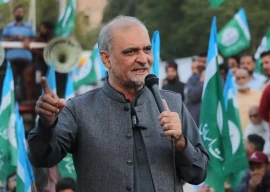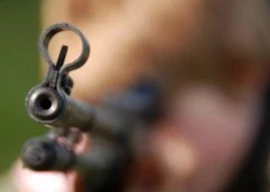
To a fanciful mind, the domineering colonial-era building without doors and windows at the busy intersection of Dina Mohammad Wafai Road and Mohammad Bin Qasim Road, a few hundred metres away from the Sindh Secretariat, appears haunted.
Coming across it for the first time, one cannot help but slow down to take in its eerie appearance, crowned by a cupola that tells the tale of a glorious but long-forgotten past.
This is Karachi’s Shafqat House - a heritage site fast losing its beauty to years of neglect. But this ghost of the past has held onto its charm, drawing some to its rooftop to see the deteriorating cupola that sets it apart from other colonial-era buildings.
Yet its charm hasn’t proven enough to convince the relevant authorities and the city’s people to work for its restoration and preservation, or to take ownership of it.
A tale of abandonment
The three-storey structure houses approximately 40 apartments and around half a dozen shops. Though it is mostly empty, a family still resides on the first floor, while a tailor shop runs on the second floor. The third floor, as the building’s occupants put it, is a no-go zone.
“It is dangerous,” was all one resident would say on the matter. He went on, “We are the chowkidaars [guards] of this building,” insisting that it was in good condition.
But the crumbling facade tells a different tale.
While one resident claimed its doors, windows and balcony fencing were taken away by erstwhile residents around five years ago, a shopkeeper there said that these, made of iron, were dismantled and stolen by drug addicts.
They explained that the owner, Ghani Bhai, died years ago, while his family abroad continued to collect rent via a secretary.
This detail, nevertheless, was insignificant in the face of their current predicament.
While the resident sorrowfully expressed the belief that the heritage structure would soon be demolished, the shopkeeper claimed residents were forced to leave.
“From what I know, the owner wants to construct a plaza in its place,” he alleged, adding that though the building looked splendid when he moved his shop there, it had been destroyed by drug addicts and neglect.
A lack of ownership
The neglect is apparent in the fact that the rear portion of this historical treasure being turned into a cattle market went unnoticed by the authorities.
“Cattle owners have been renting it for two years. They pay good rent,” the shopkeeper stated. “No one takes ownership of this building now - neither the government, nor the owners.”
Given this, antiquities and archaeology department director general Manzoor Ahmed Kansiaro’s narration of an attempt to demolish it about two years ago comes as no surprise.
“The attempt was averted by my department,” he claimed. “This building is listed as a heritage site so no one can demolish it or destroy its original grace.”
He elaborated that though the government did not own Shafqat House, his department provided the owners of such buildings with free consultations on architecture, albeit without financial support.
In the case of Shafqat House, however, he admitted to “not exactly knowing who the owners are” or having any documentation about the building.
“So we cannot get an FIR registered against anyone for defacing this heritage site,” he explained, adding that his team would check if any other attempts to demolish it had been made, apart from the one two years ago.
Not the only one
The tragedy of Karachi being robbed of its heritage is not just limited to Shafqat House.
“There are several such buildings in this area. Our history is vanishing,” rued Ahmed, who lives near Shafqat House, adding that the government was uninterested in protecting heritage sites.
Architect Yasmeen Lari explained that builders made better offers to the owners of such sites than the government, adding that funding was not really the issue when it came to their preservation.
Instead, she claimed, the problem lay in the apathy of those assigned the duty of preserving and protecting heritage sites.
Lari pointed out that the encroachment and demolition of such buildings started around 26 years ago. “No one cares. Even the government plans to demolish 55 more [such] buildings in Karachi,” she said, stressing the urgent need to protect and save these heritage buildings. “It’s a collective responsibility. We must save them for our future generations.”
Published in The Express Tribune, August 5th, 2020.
1732498967-0/Outer-Banks--(1)1732498967-0-405x300.webp)
1732086766-0/BeFunky-collage-(74)1732086766-0-165x106.webp)















COMMENTS
Comments are moderated and generally will be posted if they are on-topic and not abusive.
For more information, please see our Comments FAQ